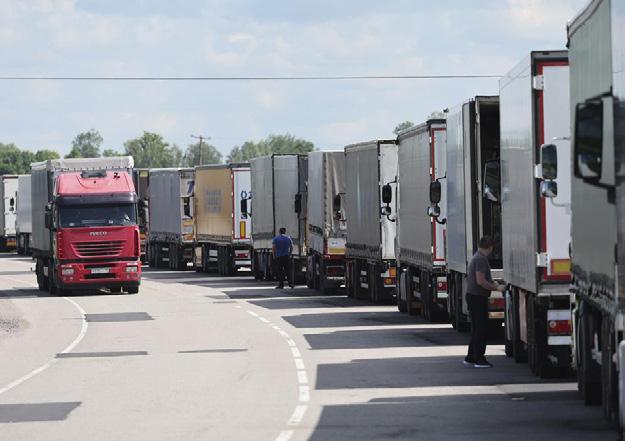
4 minute read
Kaliningrad Tightrope
KALININGRAD WALKS TIGHTROPE
With road and rail transit capacity cut as a result of the application of sanctions the Russian exclave of Kaliningrad finds itself in a worsening position. Oleksandr Gavrylyuk reports
On 18 June this year, Lithuania, a European Union memberstate, halted the rail transit of cargoes subject EU sanctions between mainland Russia and its Kaliningrad exclave via Lithuanian territory. Three days later, Lithuania took the same course of action with the road haulage of sanctionhit goods.
The EU-imposed sanctions covered some 30-35 per cent of the overall traffic between the mainland and exclave region, including such essential cargoes as construction materials, cement, wood, fertilisers, spare parts and some others.
The Kremlin responded with threats. Vladimir Dzhabarov, First Deputy Head of the Russian Senate’s Committee for International Affairs, stated that Lithuania’s “blockade of the Kaliningrad region” could lead to a military conflict with Moscow.
While he did not elaborate, Russia’s “independent experts” made no secret of a possible “unblocking”. As long as Belarus, which is a natural land bridge between Lithuania and mainland Russia, remains under the Kremlin’s control, Moscow will always be considering a chance to link its exclave with the satellite state.
“The most efficient solution of the Kaliningrad problem” would mean a simultaneous attack on Lithuania from both the exclave and Belarus with the objective of establishing a 100km long overland corridor along the Lithuanian-Polish border.
Alternatively known as the Suwalki Gap, it is one of NATO’s worst nightmares, as this would initially enable Russia to cut off Lithuania, Latvia and Estonia from the rest of the alliance and then to occupy all three Baltic countries.
On 13 July 2022, the European Commission gave a green light to the rail transit of certain sanction-hit cargoes via Lithuania, but only within limited volumes. On 22 July 2022, official Vilnius succumbed to the pressure. However, the traffic of military and dual-use goods and technologies, as well as the road haulage of sanction-hit goods, remained strictly prohibited…
While the Soviet Union remained a single entity, Kaliningrad’s status was not a big problem. However, after the dissolution of the USSR, the region found itself sandwiched between Poland and Lithuania, the two independent states, which eventually joined both the NATO and EU.
As long as Moscow tried to keep itself within the international legal framework, its neighbours did not interfere with the transit of goods. However, with the advent of the Kremlin’s brutal war in Ukraine, continuous threats to other parties in the region and saturation of the exclave with mass destruction weapons everything has changed.
CAPACITY CUTS
During the first three quarters of the current year, the total volume of cargoes railed to/from the Kaliningrad region via Lithuania comprised 1.7 million tonnes out of the 3.1 million tonnes permitted by the European Commission, according to Kotryna Dzikaraite, Communications Partner of LTG, Lithuania’s national railway operator. For example, only 26% of the approved volume of foodstuffs, 35% of wood, 37% of coal, 59% of ferrous metals, 60% of oils, 100% of cement and 31% of other cargoes were moved by rail.
With road haulage, 200 to 300 trucks a day used to enter the region through a border terminal prior to 18 June 2022. After this date, they had no choice, but to embark on a transBaltic maritime service. This, however, is not an effective solution. There are only a couple of aged ro-ro/train ferries operating between the mainland port of Ust-Luga Russia and that of Baltiysk in the exclave. As the available capacity was far from sufficient, the shortfall generated months-long queues of trucks and made trans-Baltic transportation 1.5 - 2 times more expensive than the overland options.
To tackle the problem, Moscow has mobilised the resources of several public and private ship operators, including those from other sea basins. In addition to the UstLuga-Baltiysk service, one more liner service has been initiated connecting Kaliningrad with Saint Petersburg’s outer harbour of Bronka.
With a number of vessels transferred from the White and Black Seas, the overall fleet deployed under the two services has expanded to 17 (as of 1 November 2022). However, only two of them (Marshal Rokossovsky and General Chernyakhovsky) are large-tonnage ferries of a relatively new design, with the remainder being small and mediumsized bulkers and ro-ro/lo-lo ships.
To change the situation dramatically, the region needs to have at least 22 large-tonnage vessels, in the opinion of Anton Alikhanov, Governor, Kaliningrad. Additionally, to make the sea freight rate equal to the rail one, he has asked the federal government to help subsidise maritime transportation. The Kremlin has earmarked over 1.37 billion roubles (around US$22 million) to ensure the shipping of up to 900,000t of various cargoes to/from the exclave by the end of the year. Next year, the subsidies may grow up to five billion roubles (US$81 million).
Meanwhile, as many Kaliningrad-registered enterprises are short of supplies and lack raw materials, they have been forced to either stop their operations or plan to do so in the near future.
8 With Lithuania








